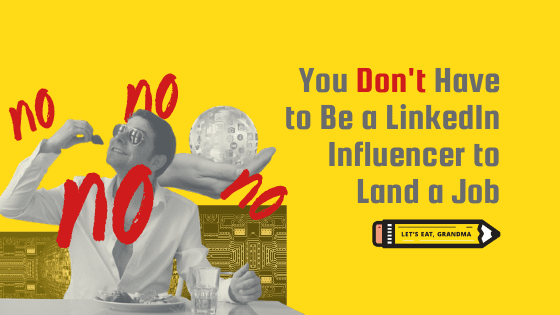How to Network on LinkedIn: No, You Don’t Have to Be an Influencer

LinkedIn can be confusing – and sometimes even intimidating. Is it just an echo chamber for influencer entrepreneurs and executives, or can it really help you further your career? In this blog post, we explore how to network on LinkedIn as the average professional.
By: Katelyn Skye Bennett | Blog Contributor for Let’s Eat, Grandma
I have a confession: I don’t understand LinkedIn sometimes. It seems like a strange platform to navigate, as both a form of social media and a professional space with the goal of career development. It can feel performative.
When I view it as virtual networking, and particularly a way to maintain contact with people I’ve met personally, LinkedIn makes more sense. But it has still taken me a long time to understand and use the platform well.
Ready for more job search help?
Sign up for a free Senior Writer Resume Critique to see what's holding you back from landing interviews. One of our top professional resume writers will give you personalized feedback on the top 3 items you can improve based on our expert practices!
I know I’m not alone in this. Raise your hand if your industry hasn’t made much use of LinkedIn thus far. Clap if you’re busy teaching and creating lesson plans offline and don’t feel like you have the time for the platform. Say “Amen” if you’re still evaluating if LinkedIn will really give you an edge.
But I do have some questions for you. Do you want to grow in your field? Will you be seeking a new job in the future? Do you want a simple way to connect with people when you run out of business cards or don’t want to crowd your email?
And if you’re currently job seeking: Do you want to be noticed by the estimated 87% of recruiters who use LinkedIn to find candidates?
LinkedIn is useful for all these things. It is a form of networking and maintaining offline networks in our virtual world, so it’s essential that we as professionals know the fundamentals. Learning how to network on LinkedIn is essential.

Interacting on LinkedIn is a great way to keep your professional connections current – no small-talk skills needed. Photo by Antenna on Unsplash.
How to Network on LinkedIn: Getting Started
First things first: Setting up your LinkedIn page. This part is straightforward.
- Include a stellar headshot, cover photo, and headline that describes the job you want and your key skills.
- Utilize the About/Summary section to its full potential. It should give a brief overview of your career so far and outline your credentials. Use your resume summary and cover letter as a guide, but feel free to use more informal language. Keep the social aspect of LinkedIn in mind when you’re crafting your profile; you get to show a little of your personality here.
- Add your professional experiences and contributions. These should mirror what is listed on your resume. However, you have more room on LinkedIn, so if there’s something you had to cut from your resume because of space concerns, here’s where you can share it. All your volunteer experience, projects … the more information the better on LinkedIn!
- List your endorsable skills at the bottom. Again, this should mirror and expand on the skills section on your resume. In addition, take a couple minutes to manually select your top three skills, rather than letting the system do it for you.
Tada! Keep this updated and you’re on your way to success.
Using LinkedIn once your profile exists does take more work, but if you’re using it correctly and properly learn how to network on LinkedIn, you’ll benefit from the process rather than waste your time.
Do It for the Mutual Gain
To use LinkedIn effectively, contribute content that adds value to others and is specific to your industry. That could mean writing your own posts or sharing relevant articles. These have the potential to elevate others’s career development and thus make the platform a useful one.
By way of example, I work as a youth career navigator during the day, assisting out-of-school youth aged 16-24 who are facing barriers to employment. This week, one of my connections, who also works with youth, shared an article about Trauma-Informed Care and another more holistic but not-yet-embraced idea: Healing-Centered Engagement. This fascinated me as a strengths-based approach and added significant value to my work.
That’s part of LinkedIn’s usefulness: You can glean from the wisdom or resources that others in your field are sharing and respond in kind.
Avoid the trap of using the platform as simply as one-sided ad space. This misuse of LinkedIn is part of what dissuades some of us from spending time there. Instead, as you navigate LinkedIn, strive for engagement – conversation, not just likes. On this platform, the quality of the content you share and the interactions you have is always more significant than the number of connections you have or likes you get.
Networking on LinkedIn is NOT a Numbers Game
With that in mind, LinkedIn won’t blow up like your Instagram. It just won’t. I mean, think about it: It’s a professional network space, not the app you spend hours scrolling through after work.
Thus, your total likes and number of connections may be smaller than on your other platforms, and that’s okay. Because again, it’s the quality of your interactions on the platform that matters most.
If your industry isn’t as present on LinkedIn, or if you’re new to the platform yourself, don’t feel like you need to add everyone in your address book, as the website or app will prompt you to do. Think about the connections that are the most meaningful to your career growth and add them. As you network both on and offline, add others who can contribute to this.

Simply adding someone who inspired you at a panel or presentation won’t do much to build your network. Follow-up and build a rapport with the presenter. Photo by Austin Distel on Unsplash.
Recently I was honored to participate in a virtual panel at my alma mater, and since then undergraduates interested in my story have reached out to me via LinkedIn to engage in career-oriented conversations as they consider nonprofit work and graduate school. I researched their profiles to respond thoughtfully in our chats. Thus, the platform enabled us to engage in purposeful conversations.
LinkedIn makes you play the long game, though. Networking is about relationship building, after all. It takes work to learn how to network on LinkedIn, as well as build and maintain those relationships.
The students who added me and conversed, asking specific questions, established a real connection and began building rapport. The students who added me after the panel but said nothing – well, to be honest, they likely won’t remember who I am in a few months, nor will I know them. Our number of LinkedIn connections is now higher, but neither of us are gaining anything at this point.
Let’s step back for a minute to remember the basics of networking. It’s that relationship building, both in your company and with folks in other organizations or social spaces, that builds rapport. This rapport can also translate into recommendations when you’re looking for work.
Leveraging Your LinkedIn Network to Advance Your Career
This takes us back to one of the reasons why you might be on LinkedIn: to explore career opportunities. While it might not be as easy as just hitting that “Easy Apply” button, using the strength of your LinkedIn connections can get you into a new job.
A little while ago, my colleague reached out to me on LinkedIn for an informational interview. A few days ago, when her name came up in the applications from my agency’s post on Indeed, I already knew a bit about her and was inclined to grant a job interview.
There are some tips and tricks to help build virtual rapport or increase engagement on LinkedIn in the long run, too.
You can comment under the posts of professional “influencers” or tag others in your posts. All the while, the point is to add value to others in your field, even as you seek that yourself. Even if your field isn’t as developed, this is a way you can contribute.
While LinkedIn can take a while to grasp, it helps to remember that there are humans behind those profile pictures. Your posts aren’t some performance or show but rather a way to connect with other professionals and build a supportive, mutually beneficial network. Learning how to network on LinkedIn, is a worthy investment.
Ready for more job search help?
Sign up for a free Senior Writer Resume Critique to see what's holding you back from landing interviews. One of our top professional resume writers will give you personalized feedback on the top 3 items you can improve based on our expert practices!
